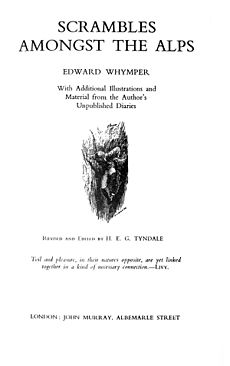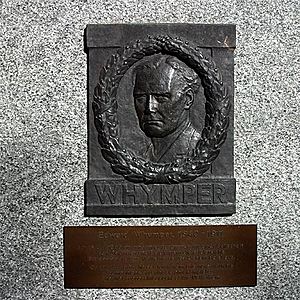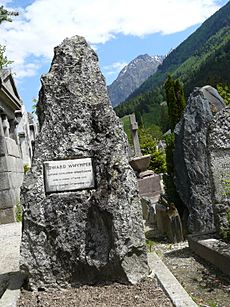Edward Whymper facts for kids

Edward Whymper, engraving, 1881
|
|
| Personal information | |
|---|---|
| Nationality | English |
| Born | 27 April 1840 London, England |
| Died | 16 September 1911 (aged 71) Chamonix, France |
| Occupation | Mountaineer, illustrator, author |
| Climbing career | |
| Known for | First ascent of the Matterhorn |
| First ascents |
|
Edward Whymper (born April 27, 1840 – died September 16, 1911) was a famous English mountaineer, explorer, artist, and writer. He is best known for being the first person to climb the Matterhorn mountain in 1865. Sadly, four members of his climbing team died during their climb down.
Whymper also made many other important first climbs. These included peaks in the Mont Blanc massif and the Pennine Alps in Europe. He also climbed Chimborazo in South America and mountains in the Canadian Rockies. His trips to Greenland helped explorers learn more about the Arctic. Whymper wrote several books about his adventures, including Scrambles Amongst the Alps.
Contents
Edward Whymper's Early Life and First Climbs
Edward Whymper was born in London, England, on April 27, 1840. His father, Josiah Wood Whymper, was an artist and a wood engraver. Edward was the second of eleven children. He learned to be a wood-engraver from a young age. This skill helped him draw amazing pictures of the places he visited.
In 1860, he traveled to the Alps mountains to draw scenery. He was hired to illustrate a failed attempt to climb Mont Pelvoux. At that time, people thought Mont Pelvoux was the highest peak in the Dauphiné Alps.
In 1861, Whymper successfully climbed Mont Pelvoux. This was the first of many trips that helped map out areas that were not well known. From the top of Mont Pelvoux, Whymper saw that another peak was even taller. This peak was later named the Barre des Écrins. Before Mont Blanc became part of France, the Barre des Écrins was the highest point in the French Alps. Whymper climbed the Barre des Écrins in 1864 with Horace Walker, A. W. Moore, and guides Christian Almer senior and junior.
From 1861 to 1865, Whymper went on many new expeditions. He made the first recorded climbs of the Aiguille d'Argentière and Mont Dolent in 1864. In 1865, he climbed the Aiguille Verte, the Grand Cornier, and Pointe Whymper on the Grandes Jorasses. He also made the first crossing of the Moming Pass that year. Whymper said his only failure was on the west ridge of the Dent d'Hérens in 1863. Because of his climbing experience, he designed a special tent. It became known as the "Whymper tent" and was used for many years.
The Famous Matterhorn Climb
Edward Whymper tried many times to climb the Matterhorn mountain. He had failed eight times before his famous climb in 1865. He believed that the Matterhorn looked steeper from one side than it actually was. He thought the other side would be easier to climb.
On July 14, 1865, Whymper and his team successfully reached the top of the Matterhorn. His team included Lord Francis Douglas, Charles Hudson, Douglas Hadow, and guides Michel Croz, Peter Taugwalder father, and Peter Taugwalder son. They reached the summit just days before an Italian team.
However, the climb down was tragic. Douglas Hadow slipped and fell, hitting Michel Croz. This caused Douglas and Hudson to fall too. The rope connecting them broke, saving Whymper and the two Taugwalder guides.
There was a big discussion about whether the rope had been cut on purpose. But an official investigation found no proof of this. Peter Taugwalder was found innocent. Whymper later found that the rope that broke was the oldest and weakest one they had. It was meant only as a backup. The stronger ropes had been used to tie the climbers who fell. Whymper always remembered the accident. He wrote:
Every night, do you understand, I see my comrades of the Matterhorn slipping on their backs, their arms outstretched, one after the other, in perfect order at equal distances—Croz the guide, first, then Hadow, then Hudson, and lastly Douglas. Yes, I shall always see them ...
Exploring Greenland and South America
After the Matterhorn, Whymper planned an expedition to Greenland in 1867. He wanted to test his route-finding skills. In Greenland, he collected many fossil plants. These were later studied and placed in the British Museum. Whymper's report on his trip was published in 1869. Even though he faced challenges like a lack of supplies, he showed that the inside of Greenland could be explored using special sledges. This was a big step forward for Arctic exploration. He went on another trip in 1872 to map the coastline.
Next, Whymper went to Ecuador in South America. His main goal was to study altitude sickness. This is how the human body reacts to less air pressure at high altitudes. His main guide there was Jean-Antoine Carrel, who later died on the Matterhorn.
In 1880, Whymper climbed Chimborazo (6,267 meters) twice. He was the first to reach its summit. He also spent a night on the top of Cotopaxi. He made first climbs of Sincholagua, Antisana, Cayambe, Sara Urco, and Cotacachi. In 1892, he wrote a book about his journey called Travels amongst the Great Andes of the Equator.
Whymper learned that altitude sickness happens because of less air pressure. This makes the air you breathe less useful. It also causes air inside your body to expand, putting pressure on your organs. His work was recognized by the Royal Geographical Society, who gave him a special medal. He also improved how barometers work at high altitudes. He wrote a book called How to Use the Aneroid Barometer.
While in Ecuador, Whymper collected many amphibians and reptiles. He gave them to the British Museum. Scientists praised his collection. Four new species were named after him, including a snake and two frogs.
Adventures in the Canadian Rockies
In the early 1900s, Whymper visited the Canadian Rockies several times. He worked with the Canadian Pacific Railway (CPR) to promote the area in Europe and Asia. In return, the CPR paid for his travel and his four guides.
In 1901, Whymper and his guides (Joseph Bossoney, Christian Kaufmann, Christian Klucker, and Joseph Pollinger) made the first climbs of Mount Whymper and Stanley Peak. These mountains are in the Vermilion Pass area of the Canadian Rockies. Edward's brother, Frederick Whymper, also has a mountain named after him in British Columbia.
Edward Whymper as an Illustrator
When he wasn't climbing, Whymper worked as an engraver. He created illustrations for books and magazines. He illustrated books for other mountaineers, like Florence Crauford Grove's The Frosty Caucasus (1875). He also illustrated and engraved John Tyndall's "Hours of Exercise in The Alps" (1871).
Later Life and Legacy
In 1906, at age 65, Whymper married Edith Mary Lewin, who was 23. They had one daughter, Ethel. They separated in 1910.
Edward Whymper became ill shortly after returning to Chamonix, France, from another climb. He died alone on September 16, 1911, at the age of 71. He is buried in the English cemetery in Chamonix.
Books by Edward Whymper
- Scrambles Amongst the Alps: In the Years 1860–69. London: John Murray, 1871.
- The Ascent of the Matterhorn. London: John Murray, 1880.
- How to Use the Aneroid Barometer. London: John Murray, 1881.
- Travels Amongst the Great Andes of the Equator. London: John Murray, 1891.
- Chamonix and the Range of Mont Blanc: A Guide. London: John Murray, 1896.
- The Valley of Zermatt and the Matterhorn: A Guide. London: John Murray, 1897.
See also
 In Spanish: Edward Whymper para niños
In Spanish: Edward Whymper para niños





